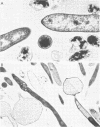Abstract
The effects of temperature, solvents, and cultural conditions on the fermentative physiology of an ethanol-tolerant (56 g/liter at 60°C) and parent strain of Clostridium thermohydrosulfuricum were compared. An ethanol-tolerant mutant was selected by successive transfer of the parent strain into media with progressively higher ethanol concentrations. Physiological differences noted in the mutant included enhanced growth, tolerance to various solvents, and alterations in the substrate range and the fermentation end product ratio. Ethanol tolerance was temperature dependent in the mutant but not in the parent strain. The mutant grew with ethanol concentrations up to 8.0% (wt/vol) at 45°C, but only up to 3.3% (wt/vol) at 68°C. Low ethanol concentration (0.2 to 1.6% [wt/vol]) progressively inhibited the parent strain to where glucose was not fermented at 2.0% (wt/vol) ethanol. Both strains grew and produced alcohols on glucose complex medium at 60°C in the presence of either 5% methanol or acetone, and these solvents when added at low concentration stimulated fermentative metabolism. The mutant produced ethanol at high concentrations and displayed an ethanol/glucose ratio (mole/mole) of 1.0 in media where initial ethanol concentrations were ≤4.0% (wt/vol), whereas when ethanol concentration was changed from 0.1% to 1.6% (wt/vol), the ethanol/glucose ratio for the parent strain changed from 1.6 to 0.6. These data indicate that C. thermohydrosulfuricum strains are tolerant of solvents and that low ethanol tolerance is not a result of disruption of membrane fluidity or glycolytic enzyme activity.
Full text
PDF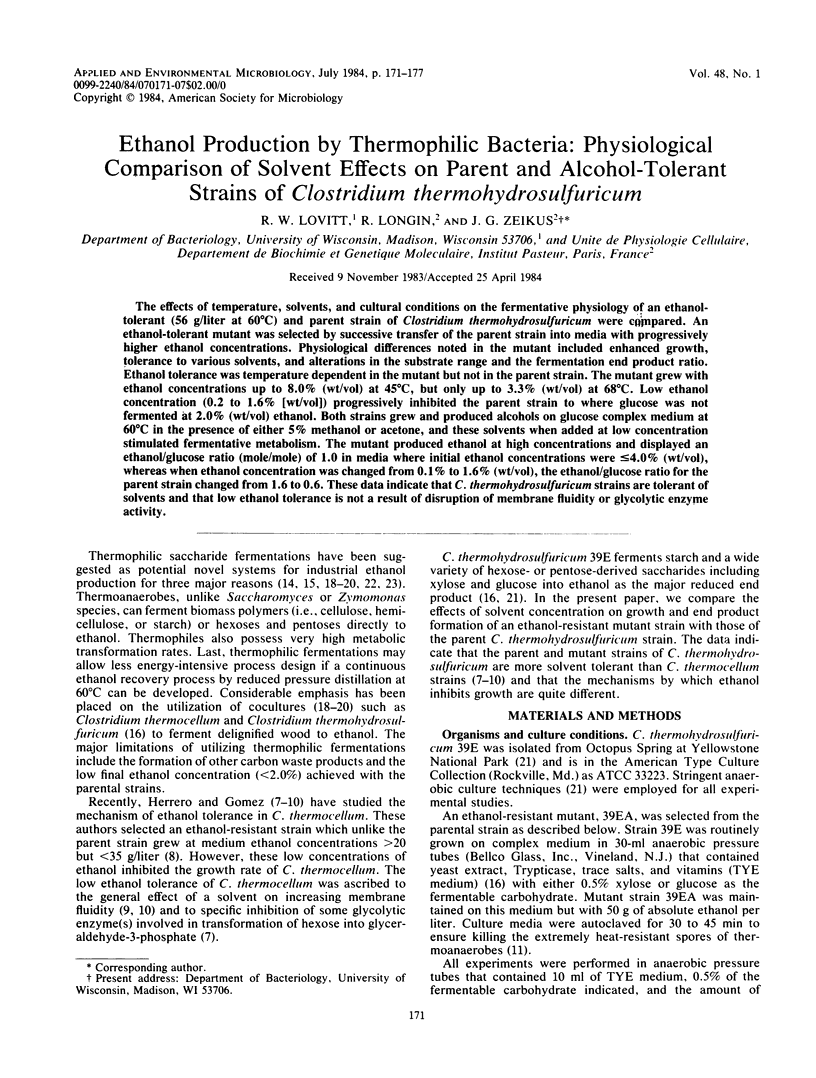
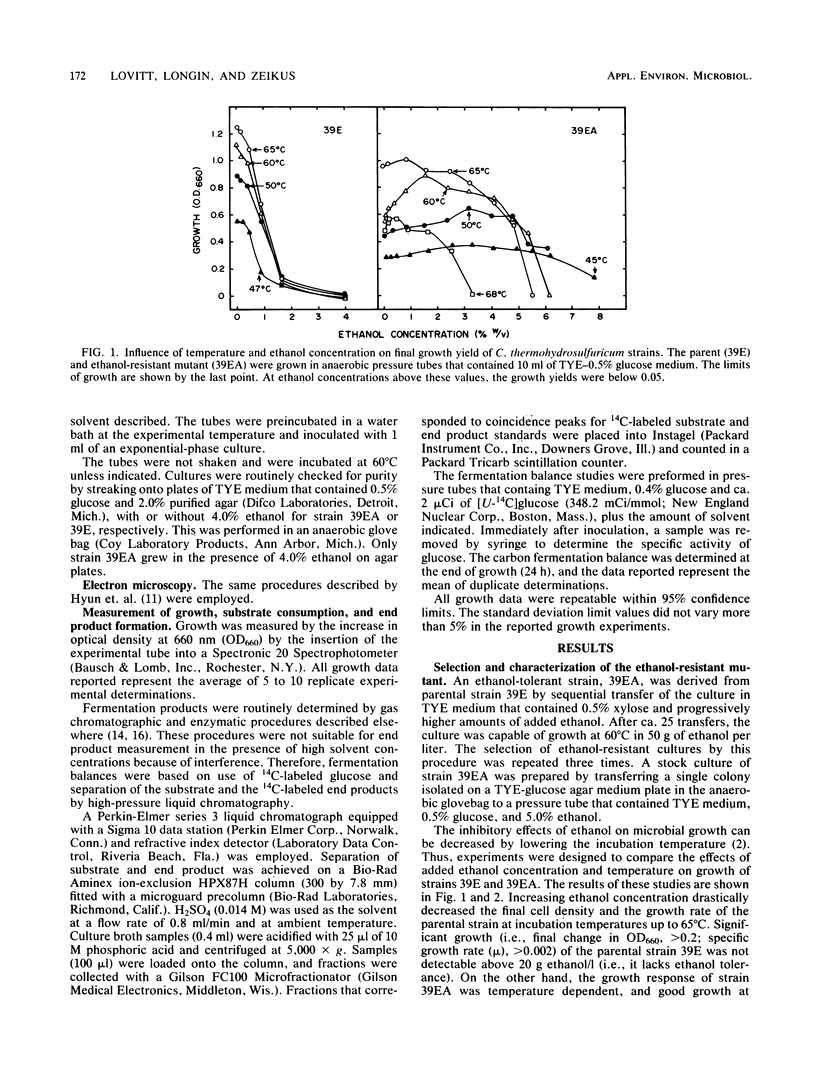
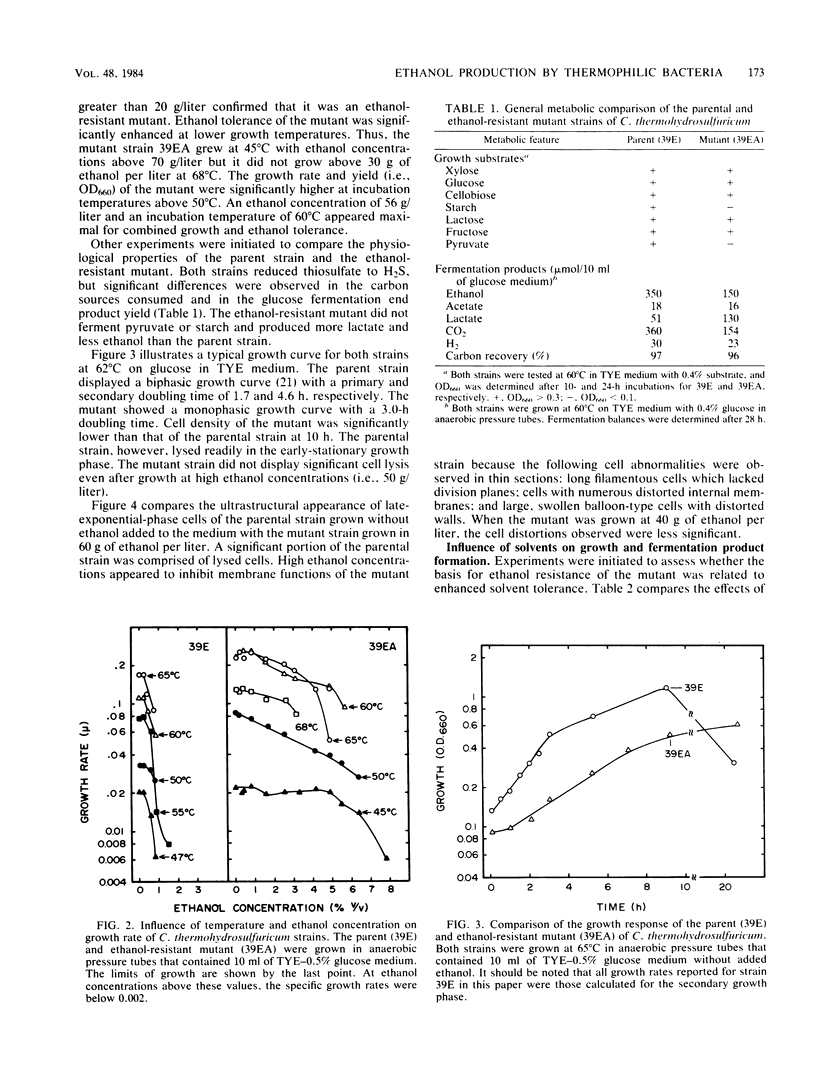
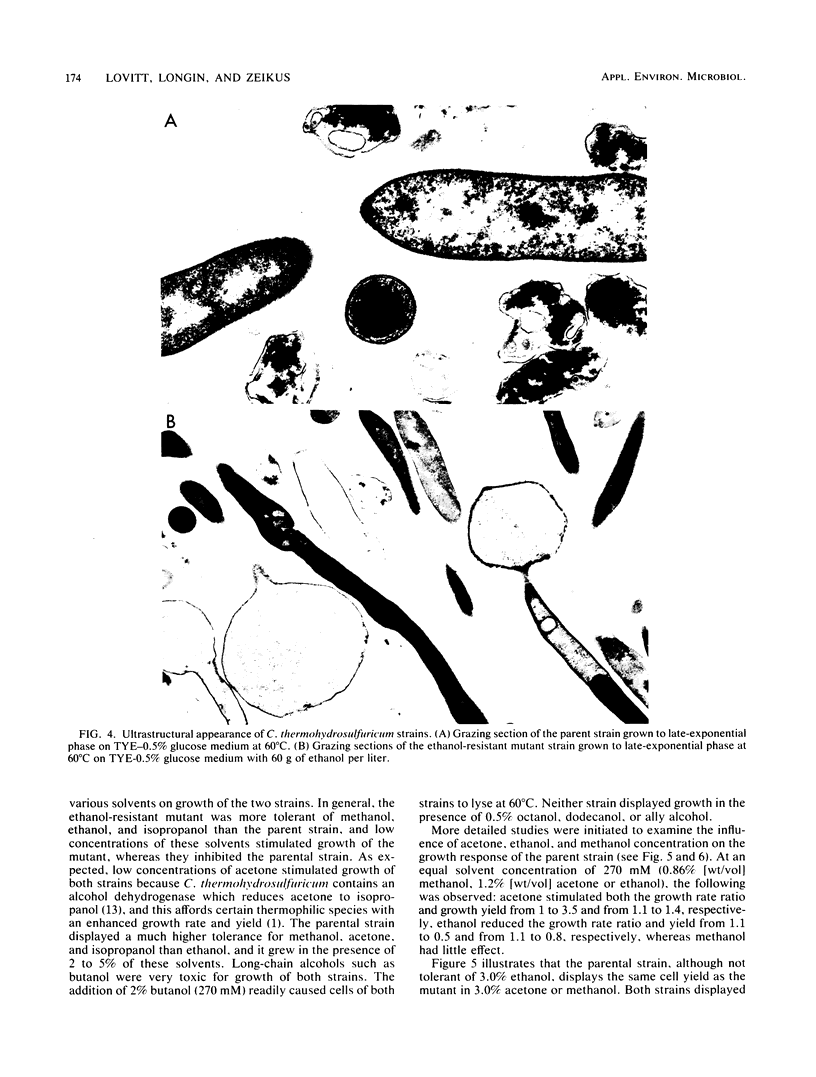
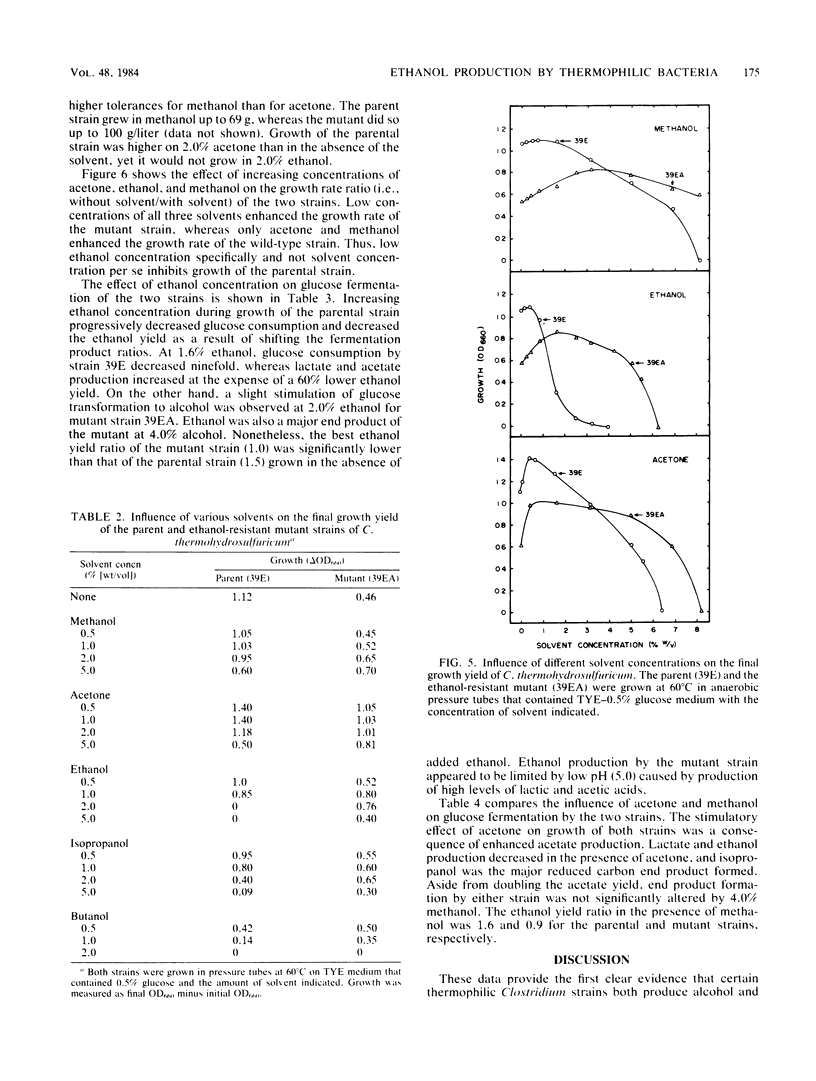
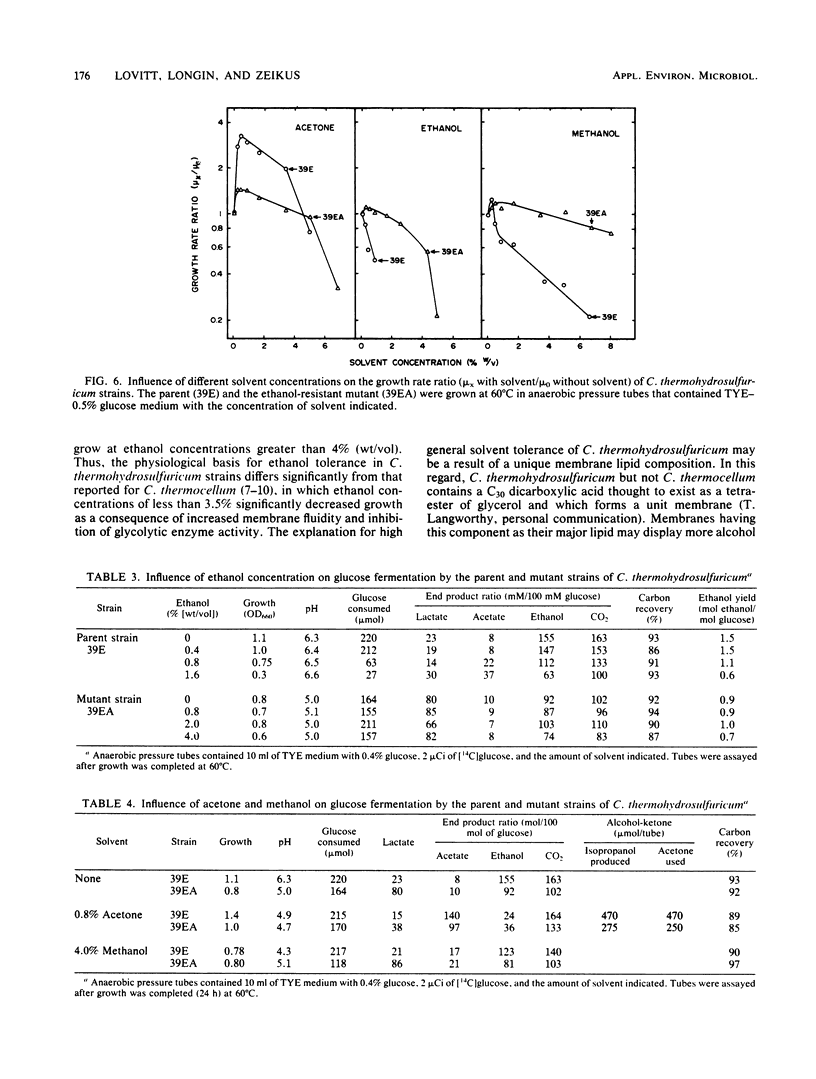
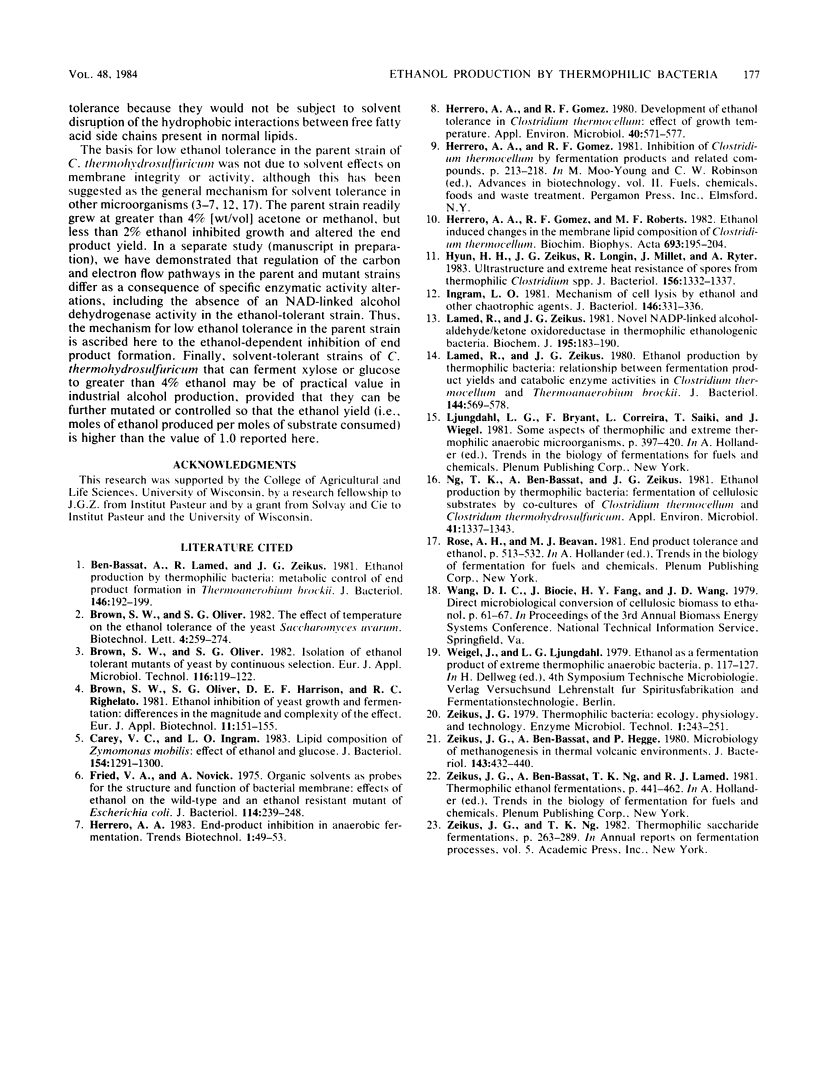
Images in this article
Selected References
These references are in PubMed. This may not be the complete list of references from this article.
- Ben-Bassat A., Lamed R., Zeikus J. G. Ethanol production by thermophilic bacteria: metabolic control of end product formation in Thermoanaerobium brockii. J Bacteriol. 1981 Apr;146(1):192–199. doi: 10.1128/jb.146.1.192-199.1981. [DOI] [PMC free article] [PubMed] [Google Scholar]
- Carey V. C., Ingram L. O. Lipid composition of Zymomonas mobilis: effects of ethanol and glucose. J Bacteriol. 1983 Jun;154(3):1291–1300. doi: 10.1128/jb.154.3.1291-1300.1983. [DOI] [PMC free article] [PubMed] [Google Scholar]
- Fried V. A., Novick A. Organic solvents as probes for the structure and function of the bacterial membrane: effects of ethanol on the wild type and an ethanol-resistant mutant of Escherichia coli K-12. J Bacteriol. 1973 Apr;114(1):239–248. doi: 10.1128/jb.114.1.239-248.1973. [DOI] [PMC free article] [PubMed] [Google Scholar]
- Herrero A. A., Gomez R. F. Development of ethanol tolerance in Clostridium thermocellum: effect of growth temperature. Appl Environ Microbiol. 1980 Sep;40(3):571–577. doi: 10.1128/aem.40.3.571-577.1980. [DOI] [PMC free article] [PubMed] [Google Scholar]
- Herrero A. A., Gomez R. F., Roberts M. F. Ethanol-induced changes in the membrane lipid composition of Clostridium thermocellum. Biochim Biophys Acta. 1982 Dec 8;693(1):195–204. doi: 10.1016/0005-2736(82)90487-4. [DOI] [PubMed] [Google Scholar]
- Hyun H. H., Zeikus J. G., Longin R., Millet J., Ryter A. Ultrastructure and extreme heat resistance of spores from thermophilic Clostridium species. J Bacteriol. 1983 Dec;156(3):1332–1337. doi: 10.1128/jb.156.3.1332-1337.1983. [DOI] [PMC free article] [PubMed] [Google Scholar]
- Ingram L. O. Mechanism of lysis of Escherichia coli by ethanol and other chaotropic agents. J Bacteriol. 1981 Apr;146(1):331–336. doi: 10.1128/jb.146.1.331-336.1981. [DOI] [PMC free article] [PubMed] [Google Scholar]
- Lamed R. J., Zeikus J. G. Novel NADP-linked alcohol--aldehyde/ketone oxidoreductase in thermophilic ethanologenic bacteria. Biochem J. 1981 Apr 1;195(1):183–190. doi: 10.1042/bj1950183. [DOI] [PMC free article] [PubMed] [Google Scholar]
- Lamed R., Zeikus J. G. Ethanol production by thermophilic bacteria: relationship between fermentation product yields of and catabolic enzyme activities in Clostridium thermocellum and Thermoanaerobium brockii. J Bacteriol. 1980 Nov;144(2):569–578. doi: 10.1128/jb.144.2.569-578.1980. [DOI] [PMC free article] [PubMed] [Google Scholar]
- Ljungdahl L. G., Bryant F., Carreira L., Saiki T., Wiegel J. Some aspects of thermophilic and extreme thermophilic anaerobic microorganisms. Basic Life Sci. 1981;18:397–419. doi: 10.1007/978-1-4684-3980-9_23. [DOI] [PubMed] [Google Scholar]
- Ng T. K., Ben-Bassat A., Zeikus J. G. Ethanol Production by Thermophilic Bacteria: Fermentation of Cellulosic Substrates by Cocultures of Clostridium thermocellum and Clostridium thermohydrosulfuricum. Appl Environ Microbiol. 1981 Jun;41(6):1337–1343. doi: 10.1128/aem.41.6.1337-1343.1981. [DOI] [PMC free article] [PubMed] [Google Scholar]
- Rose A. H., Beavan M. J. End-product tolerance and ethanol. Basic Life Sci. 1981;18:513–531. doi: 10.1007/978-1-4684-3980-9_31. [DOI] [PubMed] [Google Scholar]
- Zeikus J. G., Ben-Bassat A., Hegge P. W. Microbiology of methanogenesis in thermal, volcanic environments. J Bacteriol. 1980 Jul;143(1):432–440. doi: 10.1128/jb.143.1.432-440.1980. [DOI] [PMC free article] [PubMed] [Google Scholar]
- Zeikus J. G., Ben-Bassat A., Ng T. K., Lamed R. J. Thermophilic ethanol fermentations. Basic Life Sci. 1981;18:441–461. doi: 10.1007/978-1-4684-3980-9_26. [DOI] [PubMed] [Google Scholar]



